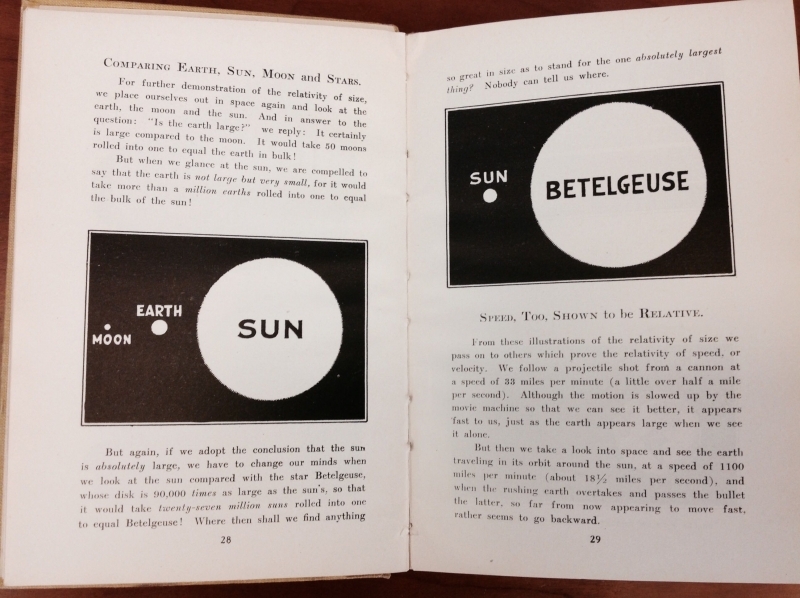
Title Page: Garret P. Serviss, The Einstein Theory of Relativity, 1923.
Einstein’s theory of relativity contains scientific principles that are commonplace in the activities of our daily lives, often without our cognizance of their effects. However, something that I struggle with as a library professional - and I’m sure many other people grapple with - is the ability to completely understand Einstein’s theory from a non-scientific viewpoint. I can read the words, but do I understand precisely what the words mean and the intricacies of how they impact my everyday life? In most instances, my answer is no.

Title Page: Garret P. Serviss, The Einstein Theory of Relativity, 1923.
One day, as I was carrying out my typical tasks, which include flagging rare books and assessing their condition, I stumbled across a book titled The Einstein Theory of Relativity in our stacks. I was pleasantly surprised to discover that the issue regarding the comprehension of Einstein’s theory by a popular audience was one that the author Garrett Serviss clearly recognized. Apparently, it was an issue that people struggled with in the past just as in the present day.
In 1923, Serviss collaborated with animators Max and Dave Fleisher (of Betty Boop and Popeye the Sailor fame) to produce a film also titled The Einstein Theory of Relativity, inspired by the German film Die Grundlagen der Einsteinschen Relativitäts-Theorie. The Fleischer film included photos and illustrations that enhanced the film’s explanations of Einstein's theory in plain language. The goal of the film was to simplify the principles of Einstein’s theory to help popular audiences better comprehend it. Likewise, Serviss utilized the film’s photos and illustrations in his book to help readers understand Einstein’s theory.
Serviss’s book was created in two parts. It was initially intended to function as a small booklet of illustrations to accompany the Fleischer film, allowing spectators to peruse the illustrations presented in the film. This booklet comprised the first part of Serviss’s book as it exists today. After the popular reception of both the film and his booklet, Serviss was encouraged to build upon the booklet’s content and expand his work into a second part as well. These two parts make up the whole of the book that we currently house in our collection.
Here are some examples of the simplified manner in which Serviss explains the Einstein theory principles. (Illustrations not to scale.)
Take a look at this first illustration, "A Straight Line Becomes a Curve.”

Illustration: "A Straight Line Becomes a Curve."
When an object or projectile travels in what appears to be a “straight” line from our point of view on the earth, it is in fact moving along a curved path due to the effect of the earth’s rotation. If you were watching the object from space, you would see the curved path.
Another visual, “Comparing Earth, Sun, Moon and Stars,” demonstrates the relativity of size:

Illustration: "Comparing Earth, Sun, Moon and Stars."
Is the earth small? Well, that depends. What are you comparing it to? Serviss tells us that it would take fifty moons to equal the size of the earth. In this case, the earth is gigantic compared to the moon.
However, if you compare the earth to the sun, the sun would most definitely win. It would take more than a million earths to equal the size of the sun!
But is the sun truly large? Not if you compare it to the star Betelgeuse. According to Serviss, it would take twenty-seven million suns to compete with the size of Betelgeuse!
If you asked me to teach you about Einstein’s relativity theory, I probably couldn’t explain it to you. But have no fear! A fully-digitized version of our book The Einstein Theory of Relativity by Serviss is available on HathiTrust here if you would like to peruse its contents! The book has many more fun illustrations for you to explore. It may be a relatively old book, but its explanations and illustrations hold up just as well today as they did when the book was first published.
Sources:
The Einstein Theory of Relativity, directed by Max and Dave Fleischer (1923; Fleischer Studios). https://youtu.be/nb7GzyUemO0.
“The Einstein Theory of Relativity.” Wikipedia. Accessed March 30, 2020. https://en.wikipedia.org/wiki/The_Einstein_Theory_of_Relativity.
“Popeye the Sailor Filmography.” Wikipedia. Accessed March 30, 2020. https://en.wikipedia.org/wiki/Popeye_the_Sailor_filmography_(Fleischer_….
Serviss, Garrett P. The Einstein Theory of Relativity. New York: Edwin Miles Fadman, Inc., 1923. https://hdl.handle.net/2027/umn.319510005021812.
Serviss, Garrett P. The Einstein Theory of Relativity. New York: Edwin Miles Fadman, Inc., 1923. Print.
Add new comment